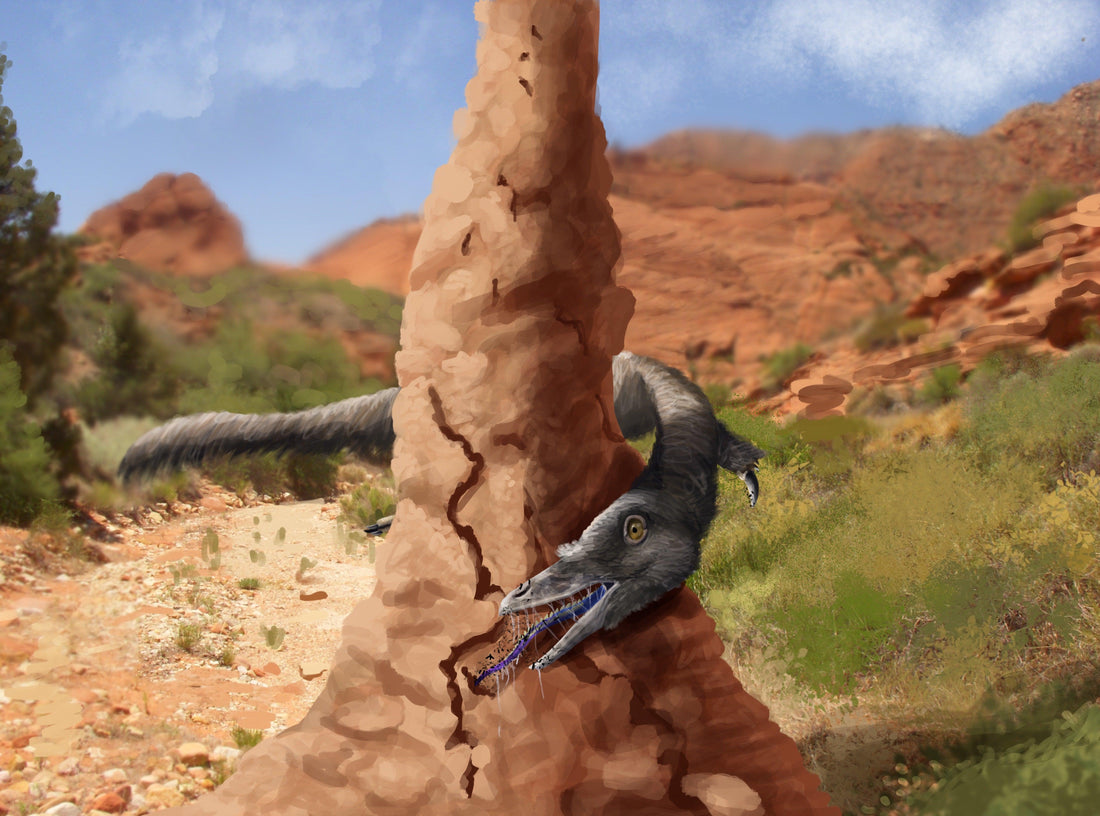
Anteating dinosaurs???
Share

Did some dinosaurs dine exclusively on ants? Myrmecophagy, literally "ant eating", exists in modern reptiles, birds, and mammals. My beloved pangolin (watch them walk bipedally here and here!), aardvark, aardwolf (insect-eating hyena relative!), armadillo, and eponymous anteater (aka Myrmecophaga, "ant eater") acquire the majority of their calories by way of crunch (ants/beetles) and/or squish (termites/larvae).
Eusocial (the scientific term for highly social organisms) insect eaters have reduced dentition, massive forearms, huge claws and cool, sticky tongues that turn termite mounds into Slurpees. Their claws enable them to dig through all but the hardest of earth and bark to munch upon colony-dwelling food sources, their sticky tongues being an efficient way to capture lots of morsels at once. Their teeth either disappear completely (think anteaters and echidnas) or become mostly undifferentiated needles.
The combination of powerful arms, odd hand claws, tubular snout, and peculiar teeth is present in a little-known group of theropod (meat-eating) dinosaurs called the alvarezsauroids.
What's an alvarezsauroid? A long-legged, short-armed, large clawed single finger with a tubeish snout theropod dinosaur. The first one ever discovered, Alvarezsaurus calvoi was named in 1991 from Late Cretaceous dinosaur fragments that resembled nothing else that had been discovered. The genus was named after historian Don Alvarez and the species after paleontologist Jorge Calvo. In the 1990s it was often interpreted to be an early flightless bird. As more specimens have been discovered in South America, Europe, and Asia we now they were widespread and grew smaller of time.
Their skeletons are fascinating with massive chest musculature, (comparatively) huge ulnae with giant olecranon processes, and a single, gigantic claw on a short arm (in comparison to their body size). This suite of features appears in fossorial animals (the scientific term for burrowers). However, burrowing animals tend not to possess tremendously long legs nor long snouts as neither of those features work well when living underground. Additionally, burrowing animals need to, well, burrow, and it is unlikely alvarezsauroids could actually use their arms to shovel dirt out of their way.
The alvarezsauroids short, stout arms do allow for lots of power, and having a single massive claw on a stout arm is an advantage for ripping open bark and earthy mounds. This rend-and-reap approach is seen today in myrmecophagous animals. My favorite is the facultatively bipedal pangolin. The pangolin bops about bipedally using its long tail as a counterbalance to its beefy forearms. The two-legged walking seems to allow it to cover more ground to hit more "fast food" restaurants in an evening. Myrmecophagous animals don't eat the entire colony, rather they rip open a section, it until the defense gets too harsh, then move on, thereby allowing the colony to replace its denizens.
Taking a closer look at alvarezsauroids, their teeth are tiny and they are lacking in the front of their tubey snouts. Modern tube-snouted animals have long tongues. Perhaps the alvarezsauroids did as well? Their jaws were clearly weak indicating they weren't devouring large chunks of flesh like their theropod cousins, nor were they cracking seeds with their jaws like other relatives. envision alvarezsauroids running about like the pangolin, covering large amounts of ground in a short amount of time to reach the next insect oasis.
To my knowledge termite mounds like what we pictured in this article have not been found (yet) in the Cretaceous. Evidence of their wood consumption is present in numerous petrified wood pieces around the world and a number of termites are known from mid-Cretaceous amber, so we know they were around. Ants appear to have been rare in the Cretaceous so perhaps the term termitophagous is more apropos?
As flowers began to dominate the world, insects, especially the eusocial ones, exploded in numbers and diversity across the Cretaceous. Alvarezsauroid physiology seems to have made them perfectly positioned to take advantage of this new food source. A recent paper suggests alvarezsauroids shrunk in size across the Cretaceous as they shifted to myrmecophagy. The majority of ant-eating animals today are of small body size, weighing less than 30 lbs. The oldest alvarezsauroids, at 6-9' long, were larger than their descendants, which became smaller over time, smaller than most of today's myrmecophagous animals.
Did dinosaurs eat ants? I believe there is a strong likelihood that the alvarezsauroids did take advantage of tiny termite protein packets, using their speed to avoid predation themselves as well as to efficiently navigate to the next colony.
Thank you kindly,
BC
PS- Thank you Dr. Nick Longrich for your many hours of SVP late-night conversation on myrmecophagous alvarezsauroids back in the 00s!
PPS- One might think, based upon its name, that the giant anteater (Myrmecophaga tridactyla) is the largest of these specialized feeders at nearly 100 lbs., however the Sloth Bear (Melursus ursinus), at over 400 lbs, dwarfs its fellow insect eaters!
1 comment
i have a plush anteater dinosaur at home, he is soft plush that keeps the ants away
and gives good hugs.